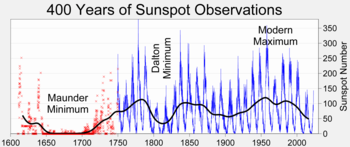蒙德極小期
| 本條目部分链接不符合格式手冊規範。跨語言链接及章節標題等處的链接可能需要清理。 (2015年12月12日) |

在黑子數量400年歷史中的蒙德極小期。
蒙德極小期(Maunder Minimum、prolonged sunspot minimum)大約是從1645年至1715年,當時的觀測者注意到太陽黑子非常罕見。太陽學家愛德華·沃爾特·蒙德(1851-1928)在研究那段時期的記錄資料時,發現這段期間的太陽黑子非常稀少,因此以他的名字來命名這一段時期。以蒙德極小期內一段30年時間為例,天文學家只觀察到約50個太陽黑子,而相對於在平常的相同時段,可以觀察到40,000-50,000顆太陽黑子。
目录
1 太陽黑子的觀察
2 小冰期
3 其他的觀測
4 相關條目
5 參考資料
6 進階讀物
7 外部連結
太陽黑子的觀察
蒙德極小期出現在1645年至1715年,相較於正常可以觀測到40,000-50,000顆太陽黑子,只觀察到50顆左右的太陽黑子。在1610年到1681年間,每10年內觀察到的太陽黑子數目如下:
| 十年期間 | 太陽黑子 |
|---|---|
| 1610 | 9 |
| 1620 | 6 |
| 1630 | 9 |
| 1640 | 2 |
| 1650 | 3 |
| 1660 | 1 |
| 1670 | 0 |
| 1680 | 1 |
在蒙德極小期的時段內,仍然有足夠多的黑子被看見,讓我們能從外推測11年週期的極大期分別是1674年、1684年、1695年1705年和1716年。
太陽黑子的活動集中在太陽的南半球,只有最後一個週期才有黑子出現在太陽的北半球。
依據史波勒定律,當週期開始時的太陽黑子會出現在較高的緯度;在極大期時太陽黑子的平均緯度是15°,然後平均值會繼續向低緯度移動至大約7°的位置。之後老週期的黑子開始消散,而新週期的黑子在高緯度區域開始出現。
這些能夠看見的太陽黑子受到太陽自轉的影響,在不同的緯度有各自的轉速:
| 太陽 緯度 | 自轉週期 (天) |
|---|---|
| 0° | 24.7 |
| 35° | 26.7 |
| 40° | 28.0 |
| 75° | 33.0 |
因為太陽的赤道(緯度0°)與黃道有7°的傾斜,所以觀測上的可見性會受到在黃道上位置的影響。
小冰期

蒙德極小期與小冰期的中間 - 最冷的一段時間 - 吻合,使當時的歐洲和北美洲,或許世界上大部分的地區,都處於嚴寒的冬季。黑子活動量的降低和寒冷的冬天之間是否有關聯,仍是持續受到爭辯的題目(參見全球暖化)。
其他的觀測

以碳輻射紀錄的太陽活動事件。
在蒙德極小期中減弱的太陽活動對抵達地球的宇宙射線也有影響。在人工製品考古學中使用的碳定年法就必須考慮碳14在數量變化上的結果。

圖形中顯示太陽活動的代理者,包括太陽黑子的數量和宇宙性同位素生成的變化。
太陽的活動也影響到鈹-10的產生以及宇宙性同位素,對它們的研究可以作為太陽活動的替代者。
歷史上其他的太陽黑子極小期也直接或間接的從冰核或年輪的碳-14分析中被發現,這些週期有史波勒極小期(1450-1540)和少被提及的道爾頓極小期(1790–1820)。看起來在過去的8,000年中有18個這樣的極小期,研究顯示太陽在這段期間有四分之一的時間是在極小期的狀態下。
一篇最近發表的論文,基於對佛蘭斯帝德繪圖的分析,認為在極度小的蒙德極小期(1666-1700)時太陽的自轉速率曾減慢[1]。
在蒙德極小期極光依然如常的被觀測到,詳細的分析已被Wilfried Schröder和J. P. Legrand等人發表(1992年)[2][3]。
以蒙德極小期為基礎的論文(Eddy, Legrand, Gleissberg, Schröder, Landsberg et al.)已經在Wilfried Schröder(Ed)發行,標題為Case studies on the Spörer, Maunder and Dalton Minima[4]。
相關條目
- 太陽極小期
傑克·埃迪- 美國天文學家。
參考資料
^ Vaquero J.M., Sánchez-bajo F., Gallego M.C. A Measure of the Solar Rotation During the Maunder Minimum. Solar Physics. 2002, 207 (2): 219. doi:10.1023/A:1016262813525.
^ Schröder, Wilfried. On the existence of the 11-year cycle in solar and auroral activity before and during the so-called Maunder Minimum. Journal of Geomagnetism and Geoelectricity. 1992, 44 (2): 119–128. ISSN 0022-1392.
^ Legrand, J. P.; Le Goff, M.; Mazaudier, C.; Schröder, W. Solar and auroral activities during the seventeenth century. Acata Geophysics and Geodetica Hungarica. 1992, 27 (2–4): 251–282. 引文使用过时参数coauthors (帮助)
^ Schröder, Wilfried. Case studies on the Spörer, Maunder, and Dalton minima. Beiträge zur Geschichte der Geophysik und Kosmischen Physik 6. Potsdam: AKGGP, Science Edition. 2005.
進階讀物
.mw-parser-output .refbegin{font-size:90%;margin-bottom:0.5em}.mw-parser-output .refbegin-hanging-indents>ul{list-style-type:none;margin-left:0}.mw-parser-output .refbegin-hanging-indents>ul>li,.mw-parser-output .refbegin-hanging-indents>dl>dd{margin-left:0;padding-left:3.2em;text-indent:-3.2em;list-style:none}.mw-parser-output .refbegin-100{font-size:100%}
Luterbach, J.; 等. The Late Maunder Minimum (1675-1715) - A Key Period for Studying Decadal Scale Climatic Change in Europe. Climatic Change. 2001, 49 (4): 441–462. doi:10.1023/A:1010667524422.
[[Willie Soon|Soon, Willie Wei-Hock]]; Yaskell, Steven H. The Maunder Minimum and the Variable Sun-Earth Connection. River Edge, NJ: World Scientific. 2003. ISBN 981-238-275-5. 引文使用过时参数coauthors (帮助); 请检查|author-link1=值 (帮助)
- What's wrong with the sun? (Nothing)
- Solar poles to become quadrupolar in May 2012 (Hinode)
外部連結
HistoricalClimatology.com, further links and resources, updated 2014
Climate History Network, network of historical climatologists, updated 2014
| |||||||||||||||||||||||||||||||||||||||||||||||
